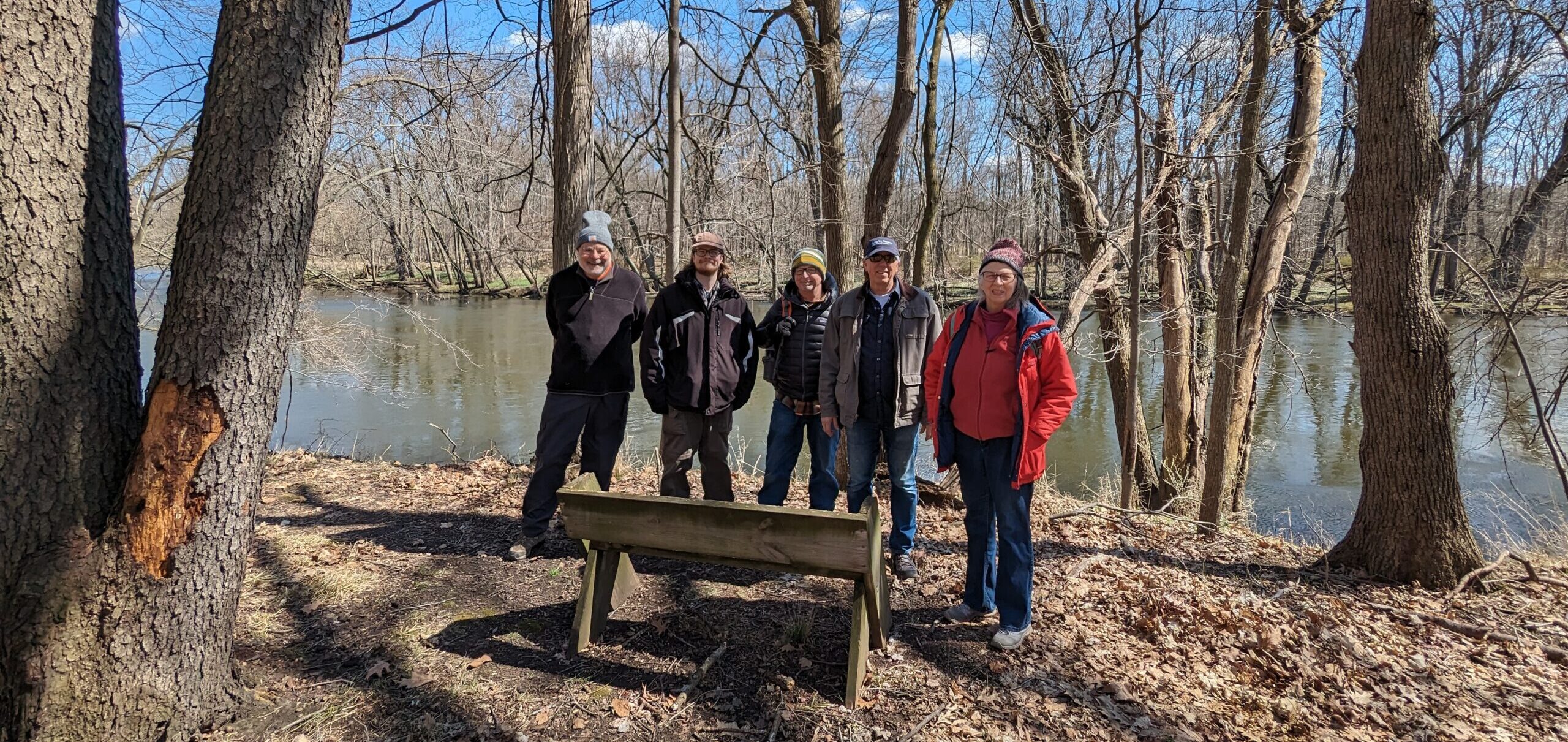Conservation Manager Chad Machinski, M.S., joined the Michigan Audubon team in March of 2023 and has made great progress in reviving the stewardship of MA’s sanctuaries and engaging with our dedicated volunteers ever since. To help you stay connected with the work being done, he will be presenting regular online updates about activities going on at them: birds seen or heard, conservation work, improvements, interesting plants, and more.
Since my last update, there has been an increase in bird, animal, and plant activity at our sanctuaries. As we get deeper into spring, each day will bring new excitement to the natural world, and each visit to a sanctuary will yield a change from the last time. That increase in the activity of the natural world brings increases in activities and events for the people who care for and are interested in nature. One such event was the Michigan Bluebird Festival, held in Ann Arbor on March 23. Hosted by the Michigan Bluebird Society, the event focuses on not just bluebirds but other birds and animals as well. Michigan Audubon held a table alongside long-time Purple Martin landlord Penny Briscoe, and we talked with many enthused guests about Purple Martins, Chimney Swifts, native plants, and all other birds. It was great to be around a group of passionate people and talk about species that people can help.
PURPLE MARTINS
Michigan Audubon is dedicated to advancing Purple Martin conservation in the state. If you are a Purple Martin landlord and don’t have your colony registered on our map, please do so! You an find links to register and more at michiganaudubon.org/bfc/puma/. In addition, we are working to develop a county mentor program that will better enable prospective and current Purple Martin landlords to get help from local landlords committed to assisting others in their landlord journey.
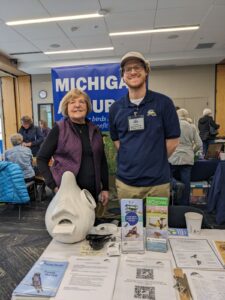
Chad Machinski (right) with Penny Briscoe (left), the "expert" Purple Martin Landlord in Michigan. Penny hosted a table next to Michigan Audubon to assist in Purple Martin conservation efforts. Photo by Murphy Harrington
CAPITAL CITY BIRD SANCTUARY
Out at our Capital City Bird Sanctuary, one plant I am not enthused about seeing activity from began popping up and will be fully flowering when this blog is published. That plant is fig buttercup, also known as lesser celandine; its scientific name is Ficaria verna. This introduced and invasive plant is a spring ephemeral, which is an uncommon thing. Fig buttercup has spread rapidly along the Grand River, where the bulblets on its stems and roots are easily carried by the river and then deposited in floodplains during high water events. This plant competes and crowds out some of our most beloved native spring ephemerals, such as trout lily, bloodroot, spring beauty, and more. Our volunteer day at Capital City was spent mapping the locations of the plant along the Grand River so that I could more easily locate them for treatment and so that Michigan Audubon and other organizations along the river could better understand its spread. I want to thank those volunteers who came out to help locate this noxious plant! Beyond plants, the bird activity at Capital City also picked up, and I recorded 24 species within a little over an hour that morning, the highlight being a Barred Owl that was not so discretely perched on a broken white pine limb.
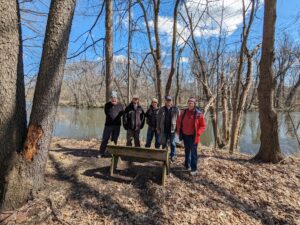
Volunteers spent time mapping fig buttercup along the Grand River at Capital City Bird Sanctuary. Photo by Chad Machinski
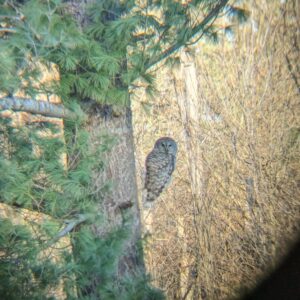
A Barred Owl perched on a white pine in Unit E1 of Capital City Bird Sanctuary next to Delta River Drive. Photo by Chad Machinski
BERNARD W. BAKER SANCTUARY
Visiting our Bernard W. Baker Sanctuary at the start of April was a bit of a doozy, and I believe it sleeted three to four times throughout the day. While staying warm by trimming trails back of brambles, I felt for the American Kestrel that looked like nothing but a fluffed-up ball sitting atop the kestrel box. That morning, 25 species were counted, one-upping my Capital City list the week prior. A Fox Sparrow was seen, which was my first of the year. I made quick visits to other parcels of Baker that are not directly attached to the nearly 1,000 acres that include Big Lake Marsh, such as a marshy area of Ackley Lake. While not directly on our property, a stop at the public boat launch at Ackley Lake yielded Canvasbacks, Ring-necked Ducks, Buffleheads, and my first of the year Osprey, and I caught it just in time to see it dive and catch a fish.
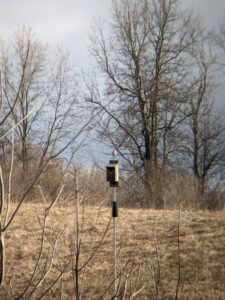
American Kestrel sitting on top of kestrel box pole in Unit S2B of Baker Sanctuary. Photo by Chad Machinski
PHYLLIS HAEHNLE MEMORIAL SANCTUARY
A few days after being out at Baker, I headed down to Grass Lake to meet with Steve Jerant of the Haehnle Committee to do some work at our Phyllis Haehnle Memorial Sanctuary. Tree Swallows were in full form that day, totaling about 23 individuals, and were jockeying with Eastern Bluebirds for housing. Steve and I worked on removing autumn olive and multiflora rose from our northernmost prairie and, during lunch, continued to add birds to our list for the day, including Wild Turkeys, a Great Egret, a Belted Kingfisher, and a Northern Harrier, all while sitting and discussing the distinct differences between Oreos and Hydrox cookies.
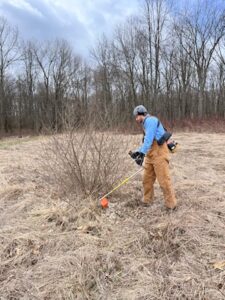
Photo of Chad Machinski cutting autumn olive with brushcutter in Unit 2.05.2. Photo by Steve Jerant
OTIS FARM BIRD SANCTUARY
This update will end with my most recent visit to our Otis Farm Bird Sanctuary, where I started the day birding with my volunteers, Scott, Eric, and Katie. We racked up 28 species that morning, which included Wilson’s Snipes that could be heard calling from the wetland and two Red-headed Woodpeckers, both of which were in an area that I had noted last year as “looks like there should be Red-headed Woodpeckers here.” Scott, Eric, and Katie helped me trim back sections of the trail that, if not for their work, would have seen blackberry canes whipping visitors by June. While more remains, it was great to get ahead of some of it before the growing season really kicks in.
I look forward to each day I’m at one of Michigan Audubon’s sanctuaries this time of year; it’s great to see things beginning to wake up.
To learn more about Michigan Audubon sanctuaries, visit michiganaudubon.org/our-conservation-impact/bird-sanctuaries. If you want to volunteer at a Michigan Audubon sanctuary, please complete the Sanctuary Volunteer Interest Form.

Chad Machinski, MS
Conservation Manager
While Chad’s first love is botany, he doesn’t deny the intertwining nature of birds, plants, insects, and all other organisms we share the world with. His passion for the natural world began in his undergraduate time at the University of Michigan, taking several different forms along the way. His graduate studies at the University of Michigan allowed him to more closely examine the natural communities of Michigan and further understand the complex nature of ecosystems. His work as a Nichols Arboretum Caretaker while in school further enabled him to be directly involved in conservation work as he led workdays removing invasive plant species, performed trail maintenance, and guided tours. Chad can usually be found out in a park in a few ways: binoculars glued to his face, hunched over looking at plants, or flipping logs looking for snakes and salamanders.

